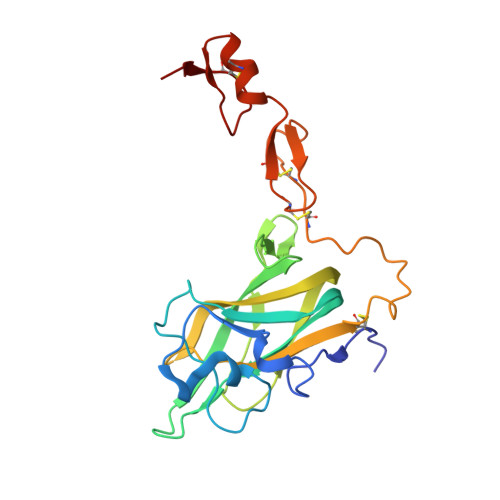Structural Basis for Selective Vascular Endothelial Growth Factor-A (VEGF-A) Binding to Neuropilin-1.
Parker, M.W., Xu, P., Li, X., Vander Kooi, C.W.(2012) J Biol Chem 287: 11082-11089
- PubMed: 22318724
- DOI: https://doi.org/10.1074/jbc.M111.331140
- Primary Citation of Related Structures:
4DEQ - PubMed Abstract:
Neuropilin-1 (Nrp1) is an essential receptor for angiogenesis that binds to VEGF-A. Nrp1 binds directly to VEGF-A with high affinity, but the nature of their selective binding has remained unclear. Nrp1 was initially reported to bind to the exon 7-encoded region of VEGF-A and function as an isoform-specific receptor for VEGF-A(164/165). Recent data have implicated exon 8-encoded residues, which are found in all proangiogenic VEGF-A isoforms, in Nrp binding. We have determined the crystal structure of the exon 7/8-encoded VEGF-A heparin binding domain in complex with the Nrp1-b1 domain. This structure clearly demonstrates that residues from both exons 7 and 8 physically contribute to Nrp1 binding. Using an in vitro binding assay, we have determined the relative contributions of exon 7- and 8-encoded residues. We demonstrate that the exon 8-encoded C-terminal arginine is essential for the interaction of VEGF-A with Nrp1 and mediates high affinity Nrp binding. Exon 7-encoded electronegative residues make additional interactions with the L1 loop of Nrp1. Although otherwise conserved, the primary sequences of Nrp1 and Nrp2 differ significantly in this region. We further show that VEGF-A(164) binds 50-fold more strongly to Nrp1 than Nrp2. Direct repulsion between the electronegative exon 7-encoded residues of the heparin binding domain and the electronegative L1 loop found only in Nrp2 is found to significantly contribute to the observed selectivity. The results reveal the basis for the potent and selective binding of VEGF-A(164) to Nrp1.
Organizational Affiliation:
Department of Molecular and Cellular Biochemistry and Center for Structural Biology, University of Kentucky, Lexington, Kentucky 40536, USA.















